最新人教版七年级下册英语语法重点
人教版初一(下)英语重点语法汇总
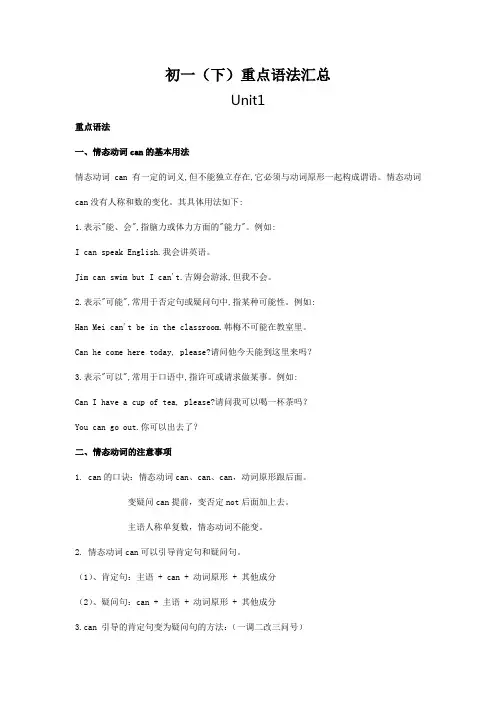
初一(下)重点语法汇总Unit1重点语法一、情态动词can的基本用法情态动词can有一定的词义,但不能独立存在,它必须与动词原形一起构成谓语。
情态动词can没有人称和数的变化。
其具体用法如下:1.表示"能、会",指脑力或体力方面的"能力"。
例如:I can speak English.我会讲英语。
Jim can swim but I can't.吉姆会游泳,但我不会。
2.表示"可能",常用于否定句或疑问句中,指某种可能性。
例如:Han Mei can't be in the classroom.韩梅不可能在教室里。
Can he come here today, please?请问他今天能到这里来吗?3.表示"可以",常用于口语中,指许可或请求做某事。
例如:Can I have a cup of tea, please?请问我可以喝一杯茶吗?You can go out.你可以出去了?二、情态动词的注意事项1. can的口诀:情态动词can、can、can,动词原形跟后面。
变疑问can提前,变否定not后面加上去。
主语人称单复数,情态动词不能变。
2. 情态动词can可以引导肯定句和疑问句。
(1)、肯定句:主语 + can + 动词原形 + 其他成分(2)、疑问句:can + 主语 + 动词原形 + 其他成分3.can 引导的肯定句变为疑问句的方法:(一调二改三问号)(1)、can 提前,首字母大写。
(一调)(2)、肯定句中主语在变成疑问句时的变化。
(二改)如:肯定句:You can feed the animals.你可以喂动物。
疑问句:Can I feed the animals?我能喂动物吗?(3)、在句尾后面加问号。
(三问号)4. Can的一般疑问句回答:(1)、肯定回答:Yes,主语(必须人称代词) + can.(2)、否定回答:No,主语(必须人称代词) + can not (can’t)/mustn’t.Yes 或 no 后要使用逗号,除了I 以外,其他人称都要小写。
人教版七年级英语下册语法重点归纳
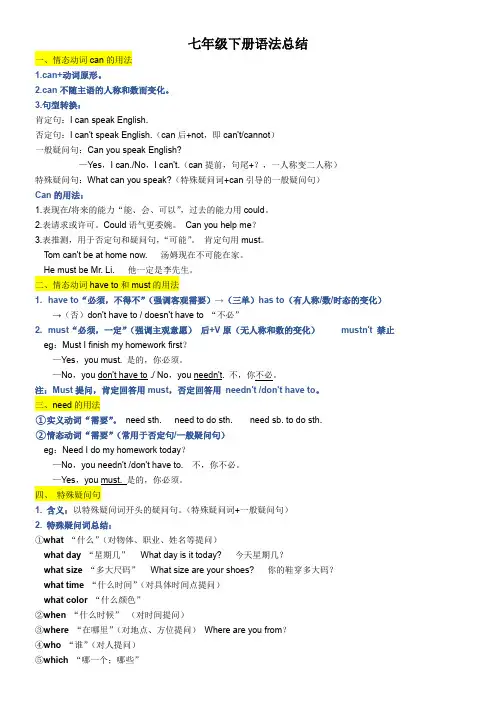
七年级下册语法总结一、情态动词can的用法1.can+动词原形。
2.can不随主语的人称和数而变化。
3.句型转换:肯定句:I can speak English.否定句:I can't speak English.(can后+not,即can't/cannot)一般疑问句:Can you speak English?—Yes,I can./No,I can't.(can提前,句尾+?,一人称变二人称)特殊疑问句:What can you speak?(特殊疑问词+can引导的一般疑问句)Can的用法:1.表现在/将来的能力“能、会、可以”,过去的能力用could。
2.表请求或许可。
Could语气更委婉。
Can you help me?3.表推测,用于否定句和疑问句,“可能”。
肯定句用must。
Tom can't be at home now. 汤姆现在不可能在家。
He must be Mr. Li. 他一定是李先生。
二、情态动词have to和must的用法1. have to“必须,不得不”(强调客观需要)→(三单)has to(有人称/数/时态的变化)→(否)don't have to / doesn't have to “不必”2. must“必须,一定”(强调主观意愿)后+V原(无人称和数的变化)mustn't 禁止eg:Must I finish my homework first?—Yes,you must. 是的,你必须。
—No,you don't have to ./ No,you needn't. 不,你不必。
注:Must提问,肯定回答用must,否定回答用needn't /don't have to。
三、need的用法①实义动词“需要”。
need sth. need to do sth. need sb. to do sth.②情态动词“需要”(常用于否定句/一般疑问句)eg:Need I do my homework today?—No,you needn't /don't have to. 不,你不必。
完整版)新人教版|七年级下册英语所有语法知识点全汇总

完整版)新人教版|七年级下册英语所有语法知识点全汇总一。
情态动词can的用法can+动词原形,不随主语的人称和数而变化。
肯定句结构为主语+can+谓语动词的原形+其他,否定句结构为主语+can't+动词的原形+其他。
一般疑问句将can提前,结构为Can+主语+动词原形+其他?肯定回答为Yes,主语+can,否定回答为No,主语+can't。
特殊疑问句结构为特殊疑问词+can+主语+动词原形+其他。
例如,I can speak English.→I can't speak English.→Can you speak English?→What can you speak?二。
XXX和when引导的特殊疑问句询问钟点时使用what time,询问日期、月份、年份时使用when。
What's the time?可以等同于What time is it。
用于询问现在的时间。
时刻表达法有顺读法和逆读法。
顺读法直接读出“钟点+分钟”的数字,例如7:05读作seven five,8:16读作eight sixteen。
逆读法使用介词past或to,先说分钟再说钟点。
当分钟不超过30分钟时,即30,用to表示,结构为“所差分钟(即60—所过分钟数)+to+下一个整点”,to译成“差”,差几分钟到几点,例如4:o to five。
当分钟为30分钟时用half表示,当分钟为15分钟时用a XXX表示。
三。
how引导的特殊疑问句how引导的特殊疑问句用于询问交通方式,其答语分为三种情况:a。
take a/an/the+交通工具(单数);b。
by+交通工具(单数);XXX限定词+交通工具。
例如,How do you go to school every day。
可以回答为I take a bus to go to school every day./I go to school by bus every day./I go to school on the bus every day.How far is something。
期末复习人教版英语七年级下册单元重点知识点语法汇总
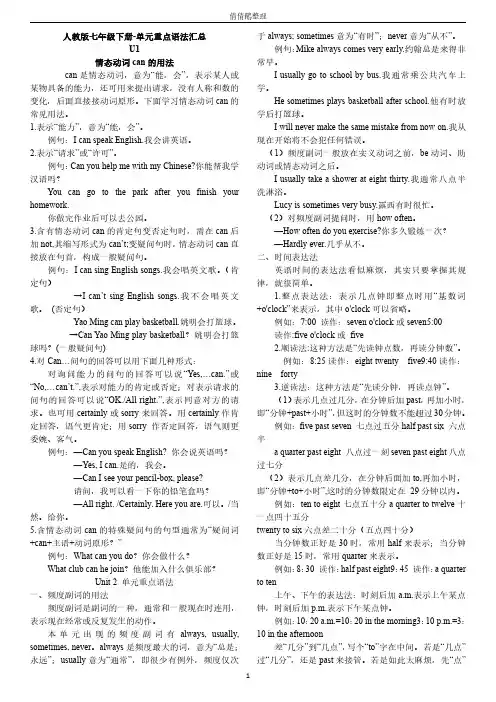
人教版七年级下册-单元重点语法汇总U1情态动词can的用法can是情态动词,意为“能,会”,表示某人或某物具备的能力,还可用来提出请求,没有人称和数的变化,后面直接接动词原形。
下面学习情态动词can的常见用法。
1.表示“能力”,意为“能,会”。
例句:I can speak English.我会讲英语。
2.表示“请求”或“许可”。
例句:Can you help me with my Chinese?你能帮我学汉语吗?You can go to the park after you finish your homework.你做完作业后可以去公园。
3.含有情态动词can的肯定句变否定句时,需在can后加not,其缩写形式为can’t;变疑问句时,情态动词can直接放在句首,构成一般疑问句。
例句:I can sing English songs.我会唱英文歌。
(肯定句)→I can’t sing English songs.我不会唱英文歌。
(否定句)Yao Ming can play basketball.姚明会打篮球。
→Can Yao Ming play basketball?姚明会打篮球吗?(一般疑问句)4.对Can…问句的回答可以用下面几种形式:对询问能力的问句的回答可以说“Yes,…can.”或“No,…can’t.”,表示对能力的肯定或否定;对表示请求的问句的回答可以说“OK./All right.”,表示同意对方的请求。
也可用certainly或sorry来回答。
用certainly作肯定回答,语气更肯定;用sorry作否定回答,语气则更委婉、客气。
例句:—Can you speak English?你会说英语吗?—Yes,I can.是的,我会。
—Can I see your pencil-box,please?请问,我可以看一下你的铅笔盒吗?—All right./Certainly.Here you are.可以。
人教版七年级英语下册重点短语及语法梳理
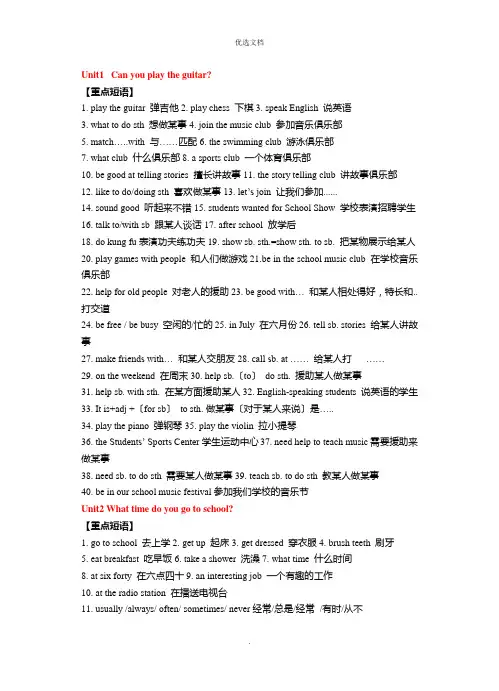
Unit1 Can you play the guitar?【重点短语】1. play the guitar 弹吉他2. play chess 下棋3. speak English 说英语3. what to do sth 想做某事4. join the music club 参加音乐俱乐部5. match…..with 与……匹配6. the swimming club 游泳俱乐部7. what club 什么俱乐部8. a sports club 一个体育俱乐部10. be good at telling stories 擅长讲故事11. the story telling club 讲故事俱乐部12. like to do/doing sth 喜欢做某事13. let’s join 让我们参加......14. sound good 听起来不错15. students wanted for School Show 学校表演招聘学生16. talk to/with sb 跟某人谈话17. after school 放学后18. do kung fu表演功夫练功夫19. show sb. sth.=show sth. to sb. 把某物展示给某人20. play games with people 和人们做游戏21.be in the school music club 在学校音乐俱乐部22. help for old people 对老人的援助23. be good with… 和某人相处得好,特长和..打交道24. be free / be busy 空闲的/忙的25. in July 在六月份26. tell sb. stories 给某人讲故事27. make frie nds with… 和某人交朋友28. call sb. at …… 给某人打……29. on the weekend 在周末30. help sb.〔to〕do sth. 援助某人做某事31. help sb. with sth. 在某方面援助某人32. English-speaking students 说英语的学生33. It is+adj +〔for sb〕to sth. 做某事〔对于某人来说〕是…..34. play the piano 弹钢琴35. play the violin 拉小提琴36. the Students’ Sports Center学生运动中心37. need help to teach music 需要援助来做某事38. need sb. to do sth 需要某人做某事39. teach sb. to do sth 教某人做某事40. be in our school music festival 参加我们学校的音乐节Unit2 What time do you go to school?【重点短语】1. go to school 去上学2. get up 起床3. get dressed 穿衣服4. brush teeth 刷牙5. eat breakfast 吃早饭6. take a shower 洗澡7. what time 什么时间8. at six forty 在六点四十9. an interesting job 一个有趣的工作10. at the radio station 在播送电视台11. usually /always/ often/ sometimes/ never 经常/总是/经常/有时/从不12. your radio show 你的播送节目13. from …..to 从….到…..14. at night 在夜晚15. a funny time 一个有趣的时间16. take exercise 锻炼17. be late for….. 因… 迟到18. at about ten twenty 在大约十点二十19. on weekends 在周末20. on school days 在上学日21. half past six 六点半22. a quarter past three 三点过一刻〔3:15〕23. a quarter to ten 十点差一刻〔9:45〕24. do 〔one’s〕homework 做〔某人的〕家庭作业25. take a walk 散步26. go to bed 睡觉27. eat quickly 吃得快28. have much time 有许多时间29. half an hour 半个小时30. get home 到达家31. either…..or 或者…….或者...... 32. eat a good breakfast 好好吃顿早餐33. lots of = a lot of 许多34. be good for….. 对…….有益35. taste good 尝起来好36. do her homework 做她的家庭作业37. have a healthy life 有一个健康的生活方式38. have dinner 吃晚饭Unit3 How do you get to school?【重点短语】1. get to school 到达学校2. take the train 乘火车3. take the subway 乘地铁4. ride a bike 骑自行车5. how do you get to school 怎么到达学校6. one hundred and five 1057. how far 多远8. how long 多长时间9. it takes sb some time to do sth 它花费某人多长时间做某事10. ride the bike to school 骑自行车到学校11. walk to , drive to ,fly to…步行去…;开车去…;坐飞机去….12. every day 每天13. I’m not sure 我不敢确信14. about= around 大约15. 10 kilometers 十公里16. good exercise 好的锻炼17. drive his car to work 开车去上班18. in his father’s car 坐父亲的车19. need about 10 minutes to get to school 需要十分钟的时间到达学校20. what do you think of=how do you like你觉得怎么样21. cross the river 过河22. It is easy to get to school. 到达学校很简单。
(完整版)新人教版英语七年级下册1-12单元知识点归纳
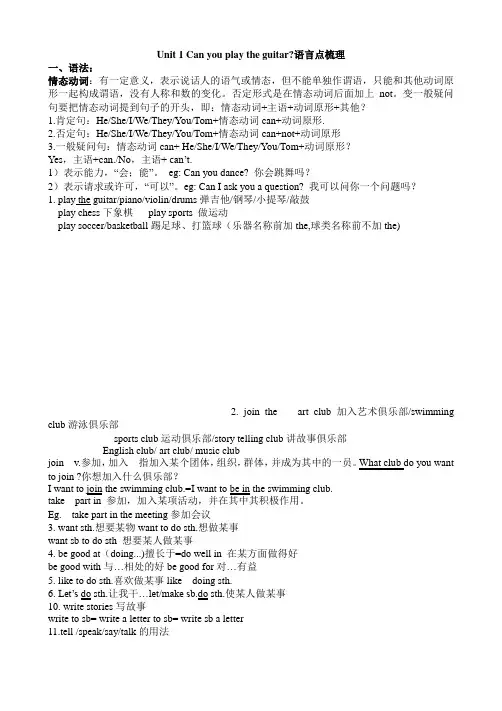
Unit 1 Can you play the guitar?语言点梳理一、语法:情态动词:有一定意义,表示说话人的语气或情态,但不能单独作谓语,只能和其他动词原形一起构成谓语,没有人称和数的变化。
否定形式是在情态动词后面加上not。
变一般疑问句要把情态动词提到句子的开头,即:情态动词+主语+动词原形+其他?1.肯定句:He/She/I/We/They/You/Tom+情态动词can+动词原形.2.否定句:He/She/I/We/They/You/Tom+情态动词can+not+动词原形3.一般疑问句:情态动词can+ He/She/I/We/They/You/Tom+动词原形?Yes,主语+can./No,主语+ can’t.1)表示能力,“会;能”。
eg: Can you dance? 你会跳舞吗?2)表示请求或许可,“可以”。
eg: Can I ask you a question? 我可以问你一个问题吗?1. play the guitar/piano/violin/drums弹吉他/钢琴/小提琴/敲鼓play chess下象棋play sports 做运动play soccer/basketball踢足球、打篮球(乐器名称前加the,球类名称前不加the)2. join the art club加入艺术俱乐部/swimming club游泳俱乐部sports club运动俱乐部/story telling club讲故事俱乐部English club/ art club/ music clubjoin v.参加,加入指加入某个团体,组织,群体,并成为其中的一员。
What club do you want to join ?你想加入什么俱乐部?I want to join the swimming club.=I want to be in the swimming club.takeEg. take part in the meeting参加会议3. want sth.想要某物want to do sth.想做某事want sb to do sth 想要某人做某事4. be good at(doing...)擅长于=do well in 在某方面做得好be good with与…相处的好be good for对…有益5. like to do sth.喜欢做某事like doing sth.6. Let’s do sth.让我干…let/make sb.do sth.使某人做某事10. write stories写故事write to sb= write a letter to sb= write sb a letter11.tell /speak/say/talk的用法1) tell讲述一件事实或故事等及物动词tell sb. sth 给某人讲某事=tell sth to sb 把某事告诉某人tell sb. to do sth 告诉某人做某事tell stories讲故事=tell a story tell a lie撒谎2)speak v. 主要是讲说话的能力,往往接语言speak English讲英语3)talk 为不及物动词往往加介词再接宾语talk to sb.和…交谈/talk with sb.和…交谈(指双方)4)say往往接说话的内容eg.Our teacher says we should study hard.say it in English用英语说它12. make friends with sb.和…交朋友13. play games with sb.和…做游戏14. help sb. with sth.= help sb. (to) do sth.帮助某人做某事15. call sb. at +电话号码给某人打电话拨+号码16. on /at the weekend 在周末on weekends after school放学后17.do Chinese kung fu 打中国功夫18.be free 空闲的19. sing very well 唱得好That sounds good. 那听起来很好20.English-speaking students 讲英语的学生学生运动中心23.also /too/eitheralso/too用在肯定句,also 用于句中,too 用于句尾,either用于否定句句未eg. I am a student . He is a student,too. I am a student . He is also a student.I am not a student . He is not a student, either.24.and/or 连接两个并列成分eg.I can sing and dance.(and用于肯定句)I can’t sing or dance.(or用于否定句)Can you sing or dance ?(or用于选择疑问句“或者”)25.at27. need to do sth需要干某事need sb. to do sth 需要某人干某事28.wanted students for School show学校表演招聘学生v.展示;给….看… show sb. Sth= show Sth to sb.给某人展示n.节目;表演TV show电视节目29.teach v.教,讲授teacher n.教师teach sb.English教某人英语teach sb. sth .= teach sth to sb.教给某人某事=教某事给某人teach sb.to do sth教给某人做某事30.music n.音乐musician n. 音乐家31.piano (pl.) pianosUnit 2 What time do you go to school?知识点梳理1.What time do you get up?What time +助动词do/does +主语+动词原形,询问某人做某事的具体时间。
新版人教版七年级英语下册1-12单元重点短语词组、句型
Unit 1 Can you play the guitar? 1.play chess 下国际象棋play the guitar 弹吉他弹吉他弹吉他2.speak English 说英语English club 英语俱乐部英语俱乐部3.talk to 跟…说 play the violin 拉小提琴拉小提琴拉小提琴4.play the piano 弹钢琴弹钢琴弹钢琴 play the drums 敲鼓敲鼓敲鼓5.make friends 结交朋友结交朋友6.do kung fu 会(中国)功夫会(中国)功夫会(中国)功夫 7.tell stories 讲故事讲故事 play games 做游戏做游戏 8.on the weekends (在)周末(在)周末(在)周末 用法集萃用法集萃play +棋类/球类球类 下……棋,打……球 1.play the +西洋乐器西洋乐器西洋乐器 弹/拉……乐器乐器2.be good at doing sth.= do well in doing sth. 擅长做某事3.be good with sb. 善于与某人相处善于与某人相处4.need sb. to do sth. 需要某人做某事需要某人做某事5.can + 动词原形动词原形 能/会做某事会做某事6.a little + 不可数名词不可数名词不可数名词 一点儿……7.join the …club 加入加入…俱乐部俱乐部8..like to do sth. =love to do sth. 喜欢/喜爱做某事喜爱做某事 like ding sth.喜欢做某事喜欢做某事典句必背Can you draw? Yes, I can. / No, I can’t. 1. What club do you want to join? 2. I want to join the chess club. 3. You can join the English club. Sounds good. 4. I can speak English and I can also play soccer. 5. Please call Mrs. Miller at 555-3721. 重点句子点拨:重点句子点拨:1、Can you play the guitar?你会弹吉他吗?点拨1:can 是情态动词,它的意思是能、会,表示某人具有做某事的能力,情态动词后必须用动词原形,情态动词can 没有人称和数的变化。
七年级下册英语知识点总结归纳人教版
七年级下册英语知识点总结归纳人教版七年级下册英语知识点总结归纳(人教版)在七年级下册英语学习中,我们学习了许多重要的知识点。
这些知识点涵盖了语法、词汇、句子结构以及阅读理解等方面。
下面,我们将对这些知识点进行总结归纳,以帮助大家更好地复习和掌握。
一、语法知识点1. 一般现在时:表示经常性的动作或客观事实。
主语为第三人称单数时,动词要加-s或-es。
例句:He usually goes to school by bike.They often play football on weekends.2. 一般过去时:表示过去某个时间发生的动作或存在的状态。
动词要用其过去式形式。
例句:I watched a movie last night.She lived in China for two years.3. 现在进行时:表示说话时正在进行的动作。
构成:主语+be动词(am, is, are)+动词-ing。
例句:They are playing basketball in the park.We are learning English now.4. 一般将来时:表示将来要发生的动作或存在的状态。
构成:主语+will+动词原形。
例句:I will visit my grandparents next weekend.She will be a doctor in the future.5. 情态动词:can, may, must等,表示能力、许可、必须等。
例句:You can go to the park with us.Students must wear school uniforms.6. 宾语从句:用来充当主句中动词的宾语的从句。
例句:I think that he is a good student.She knows where the nearest supermarket is.二、词汇知识点1. 动词短语:由动词与副词/介词组成的短语。
语法——人教版七年级下册必须掌握的9大英语语法点
语法丨人教版七年级下册必须掌握的9大英语语法点,这里全了!今天,韩老师要和大家分享的是新人教版七年级下册全部语法点,这样的归纳总结希望对你的英语学习有帮助,希望同学们本学期的英语学习能从量的积累到质的飞越,取得突出进步!语法01情态动词can的用法can+动词原形,它不随主语的人称和数而变化。
1. 含有can的肯定句:主语+can+谓语动词的原形+其他。
2. 含有can的否定句:主语+can't+动词的原形+其他。
3. 变一般疑问句时,把can提前:Can+主语+动词原形+其他?肯定回答:Yes,主语+can。
否定回答:No,主语+can't.4. 含有can的特殊疑问句:特殊疑问词+can+主语+动词原形+其他?I can speak English.→I can't speak English.→Can you speak English? →What can you speak?语法02what time和when引导的特殊疑问句1. 询问钟点时用what time,询问日期、月份、年份时用when。
2. What's the time?=What time is it?现在几点了?3. 时刻表达法:顺读法和逆读法。
顺读法:“钟点+分钟”直接读数字。
如:7: 05 seven five;8:16 eight sixteen逆读法:借助介词past或to表示,要先说分再说钟点。
a. 当分钟不超过30分钟时(包括30分钟),即<或=30,用past表示。
其结构为:“分钟+past+整点”意为“几点过几分”。
如:1:25 twenty-five past oneb. 当超过30分钟时,即>30,用to表示。
其结构为:“所差分钟(即60—所过分钟数)+to+下一个整点”,to译成“差”,差几分钟到几点。
如:4:38 twenty-two to fivec. 当分钟为30分钟用half表示,当分钟为15分钟用a quarter。
(完整word版)英语人教版七年级下各单元知识点和语法(word文档良心出品).doc
七年级下unit1一、短语:◆短语归纳1. play chess 下国际象棋2. play the guitar 弹吉他3. speak English 说英语4. English club 英语俱乐部5. talk to 跟说6. play the violin 拉小提琴7. play the piano 弹钢琴8. play the drums 敲鼓9. make friends 结交朋友10. do kung fu 练 (中国) 功夫11. tell stories 讲故事12. play games 做游戏13. on the weekend/on weekends 在周末14 show sth to sb = show sb sth 把某物给某人看◆用法集萃1.play + 棋类 /球类下棋,打球2. play the + 西洋乐器弹/拉乐器3. be good at doing sth.= do well in doing sth. 擅长做某事4.be good with sb. 和某人相处地好5.need sb. to do sth. 需要某人做某事6.can + 动词原形能 /会做某事◆典句必背1. Can you draw? Yes, I can. / No, I can ’ t.2. What club do you want to join? I want to join the chess club.3.You can join the English club.4.Sounds good./That sounds good.5.I can speak English and I can also play soccer.6. Please call Mrs. Miller at 555-3721.二、短语和语法:1. —Can you play the guitar? 你会弹吉他吗?—Yes, I can. 是的,我会。
- 1、下载文档前请自行甄别文档内容的完整性,平台不提供额外的编辑、内容补充、找答案等附加服务。
- 2、"仅部分预览"的文档,不可在线预览部分如存在完整性等问题,可反馈申请退款(可完整预览的文档不适用该条件!)。
- 3、如文档侵犯您的权益,请联系客服反馈,我们会尽快为您处理(人工客服工作时间:9:00-18:30)。
一. 情态动词can的用法can+动词原形,它不随主语的人称和数而变化。
1. 含有can的肯定句:主语+can+谓语动词的原形+其他。
2. 含有can的否定句:主语+can't+动词的原形+其他。
3. 变一般疑问句时,把can提前:Can+主语+动词原形+其他?肯定回答:Yes,主语+can。
否定回答:No,主语+can't.4. 含有can的特殊疑问句:特殊疑问词+can+主语+动词原形+其他?I can speak English.→I can't speak English.→Can you speak English? →What can you speak?二. what time和when引导的特殊疑问句1. 询问钟点时用what time,询问日期、月份、年份时用when。
2. What's the time?=What time is it?现在几点了?3. 时刻表达法:顺读法和逆读法。
顺读法:“钟点+分钟”直接读数字。
如:7: 05 seven five;8:16 eight sixteen逆读法:借助介词past或to表示,要先说分再说钟点。
a. 当分钟不超过30分钟时(包括30分钟),即<或=30,用past表示。
其结构为:“分钟+past+整点”意为“几点过几分”。
如:1:25twenty-five past oneb. 当超过30分钟时,即>30,用to表示。
其结构为:“所差分钟(即60—所过分钟数)+to+下一个整点”,to译成“差”,差几分钟到几点。
如:4:38 twenty-two to fivec. 当分钟为30分钟用half表示,当分钟为15分钟用a quarter。
三. how引导的特殊疑问句1. how 引导的特殊疑问句提问交通方式,其答语分三种情况:a. take a/an/the+交通工具(单数)b. by+交通工具(单数)c. on/in+限定词+交通工具---How do you go to school every day?---I take a bus to go to school every day./I go to school by bus every day./I go to school on the bus every day.2. how far 用来提问距离,多远,其答语分为两种:(1)用长度单位表示:It is five kilometers.(2)用时间表示:It’s twenty minutes’walk.3. how long 用来提问时间,意为多久回答常用“for+段时”。
----How long have you learnt English?----For 3 years.4. how soon 用来提问做完某事还需要多长时间,用于将来时态,常用“in+时间段”来回答。
----How soon will you arrive in Beijing? ----In 3 hours.四.祈使句祈使句一般表示请求、命令、劝说、号召、警告等。
一般以动词原形开头,句末可以用感叹号或句号。
1. 肯定的祈使句:(1) 实义动词原形+其他:Please look at that boy.(2) be动词原形+形容词+其他:Be quiet, please.2. 否定的祈使句:(1) Don’t+实义动词+原形Don't stand there.(2) Don’t be+形容词+其他Don't be so noisy.(4) No+n./V-ingNo photos.不许照相。
No talking. 不许谈话。
五. 现在进行时现在进行时指当前时间正在发生的动作。
常与now,at this moment,listen,look等词连用。
谓语动词结构:be+动词ing形式They are having class.He is eating lunch.变为否定句直接在be动词之后加not,其他不变;变为一般疑问句直接把be动词提到句首,其他不变。
They are having class.→They are not having class.→Are they having class?He is eating lunch.→He is not eating lunch.→Is he eating lunch?六. There be结构1. There be句型主要用以表达“某处有某人(某物),强调存在”其基本结构为“There be+某物(某人)+某地”,有时为了强调地点,也可把地点状语放在句首。
There is a book on the desk.On the desk there is a book.2. have表示“某人拥有某人或某物,强调拥有和所属关系”。
The man has two cars.3. There be句型中的就近原则,即be和距其最近的主语保持一致。
There are some pens and a book on the floor. =There is a book and some pears on the floor.七. 选择疑问句选择疑问句是指说话人提出两种或以上的情况,让对方选择是哪一种,两个选择部分用or 连接。
选择疑问句不用yes或no来回答,直接在两个选择里选一个回答。
---Is she tall or short? ---She is tall.---Can you play the piano or play the guitar? ---I can play the piano八.名词1. 名词单数变复数规则在英语里面,名词分可数名词(countable noun)和不可数名词(uncountable noun)。
不可数名词没有单复数之分,用时只当单数词用;可数名词有单复数之分,一个的前面要用a或an,eg: a pencil, a basketball, a dictionary, an egg, an ID card,而复数即两个或两个以上的要作相应的变化,情况如下:(1)一般的词在单数词后直接+“s”book→books,pen→pens,car→cars,map→maps,cartoon→cartoons(2)以s,x,sh,ch结尾的词+“es”box→boxes,watch→watches(3)以辅音字母+y结尾的名词去掉“y”,改成“i”,再加“es”family→families,comedy→comedies(4)以f或fe结尾的词,先去掉f或fe,改成“v”再加esknife→knives,wife→wives,handkerchief→handkerchieves(5) 特殊词,特殊变化,需单独记:child→children,man→men,foot→feet,woman→womentooth→teeth,sheep→sheep,deer→deer2. 既是可数名词又是不可数名词的单词chicken当“鸡肉”讲时是不可数,当“小鸡”讲时可数;room当“空间”讲时不可数,当“房间”讲时可数;fish当食物用“鱼、鱼肉”讲时不可数,当“鱼的种类”讲时可数;hair泛指“毛发”时不可数,当“一根或几根毛发”讲时可数;sound意思是“一般性的声音”时,不可数,指“一次发出的声音”时可数;paper当“纸”讲时不可数,当“试卷”、“论文”、“证件”讲时可数;time当“时间”讲时不可数,当“时代、倍数、次数”讲时可数;exercise泛指“锻炼”时不可数,当“练习、做操”讲时可数九. 一般过去时一般过去时表示在过去某个时间所发生的动作或所处的状态(与现在无关)。
常与yesterday, last week, in 1989, just now, a moment ago, the other day等过去具体时间状语连用。
He was here just now.他刚才还在这里。
What did you do yesterday?你昨天做了什么事?一般过去时基本结构1. 肯定句形式:主语+动词过去式+其他I was an English teacher one year ago.一年前我是一名英语老师。
I bought a yellow dress yesterday afternoon.昨天下午我买了一条黄裙子。
2. 否定句形式:①was/were+not; ②在行为动词前加didn't,同时还原行为动词I wasn't an English teacher one year ago.一年前我不是一名英语老师。
I didn't buy a yellow dress yesterday afternoon.昨天下午我没买一条黄裙子。
3. 一般疑问句:①was/were提到句首;②Did+主语+动词原形+其他?Were you an English teacher one year ago?一年前你是一名英语老师吗?Did you buy a yellow dress yesterday afternoon?昨天下午你买了一条黄裙子吗?4. 特殊疑问句:特殊疑问词+一般疑问句What were you one year ago?一年前你是做什么的?。
